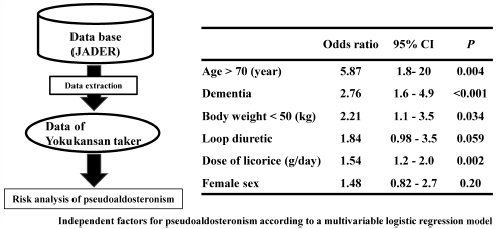- 著者
- Kei Kawada Tomoaki Ishida Kohei Jobu Tsuyoshi Ohta Hitoshi Fukuda Shumpei Morisawa Tetsushi Kawazoe Naohisa Tamura Mitsuhiko Miyamura
- 出版者
- The Pharmaceutical Society of Japan
- 雑誌
- Biological and Pharmaceutical Bulletin (ISSN:09186158)
- 巻号頁・発行日
- vol.45, no.6, pp.720-723, 2022-06-01 (Released:2022-06-01)
- 参考文献数
- 24
- 被引用文献数
- 3
Aggression is the most common adverse effect of antiepileptic drugs (AEDs). This study aimed to investigate the association of aggression with AED use. The reporting odds ratio (ROR) from adverse event reports, submitted to the Japanese Adverse Drug Event Report database between 2004 and 2020, was used to calculate and investigate the association between AEDs and aggression. We also analyzed the association of aggression with the combined use of AEDs and the relationship between AED-associated aggression and patient characteristics. A total of 433 patients developed aggression. Significant aggression signals were detected for perampanel (crude ROR: 325.04, 95% confidence interval (CI): 118.48–752.58, p < 0.01), levetiracetam (crude ROR: 17.14, 95% CI: 10.33–26.90, p < 0.01), lacosamide (crude ROR: 16.90, 95% CI: 2.02–62.51, p < 0.01), lamotrigine (crude ROR: 15.98, 95% CI: 9.99–24.39, p < 0.01), valproate (crude ROR: 6.68, 95% CI: 4.27–10.02, p < 0.01), and carbamazepine (crude ROR: 2.47, 95% CI: 1.17–4.59, p < 0.01). The combined therapy with perampanel and levetiracetam had a significant aggression signal (adjusted ROR: 25.90, 95% CI: 1.14–59.10, p < 0.01). In addition, we found that aggression frequently occurred in patients <60 year (adjusted ROR: 2.88, 95% CI: 1.49–5.56, p < 0.01) treated with levetiracetam. These results may be useful for minimizing the risk of aggression during the treatment of AEDs.
- 著者
- Tomoaki Ishida Kei Kawada Shumpei Morisawa Kohei Jobu Yasuyo Morita Mitsuhiko Miyamura
- 出版者
- The Pharmaceutical Society of Japan
- 雑誌
- Biological and Pharmaceutical Bulletin (ISSN:09186158)
- 巻号頁・発行日
- vol.43, no.10, pp.1570-1576, 2020-10-01 (Released:2020-10-01)
- 参考文献数
- 24
- 被引用文献数
- 1 18
Yokukansan is a Kampo formula that is commonly used by the elderly because it is expected to improve peripheral symptoms of dementia and delirium. However, side effects from its use are frequently reported in the elderly. In particular, pseudoaldosteronism caused by the licorice contained in yokukansan leads to hypertension, hypokalemia, and muscle weakness, which may result in death. This study aimed to identify the risk factors of pseudoaldosteronism with yokukansan use. Using cases reported in the Japanese Adverse Drug Report (JADER) database, the reporting odds ratio (ROR) was calculated and compared to assess the risk of pseudoaldosteronism for each licorice-containing Kampo formula. We also analyzed the risk factors for pseudoaldosteronism in patients taking yokukansan. Yokukansan (ROR 2.4, 95% confidence interval (CI) 1.9–2.8; p < 0.001) had a higher risk of pseudoaldosteronism than that of other licorice-containing Kampo formulas. Furthermore, the results of a logistic regression analysis in patients taking yokukansan showed that the licorice dose (OR 1.5, 95% CI 1.2–2.0; p < 0.01), older age (<70 years, OR 5.9, 95% CI 1.8–20; p < 0.01), dementia (OR 2.8, 95% CI 1.6–4.9; p < 0.001), low body weight (<50 kg, OR 2.2, 95% CI 1.1–3.5; p = 0.034) were risk factors for pseudoaldosteronism, Although not significant, treatment with loop diuretics (OR 1.8, 95% CI 0.98–3.5; p = 0.059) tended to increase the risk of pseudoaldosteronism. In summary, patients must understand the risk factors when considering taking yokukansan and reduce the licorice dose they consume.
- 著者
- Yasuyo Morita Tomoaki Ishida Shumpei Morisawa Kohei Jobu Yangran Ou Hiroko Fujita Kazuhiro Hanazaki Mitsuhiko Miyamura
- 出版者
- The Pharmaceutical Society of Japan
- 雑誌
- Biological and Pharmaceutical Bulletin (ISSN:09186158)
- 巻号頁・発行日
- vol.44, no.1, pp.32-38, 2021-01-01 (Released:2021-01-01)
- 参考文献数
- 34
- 被引用文献数
- 5
Sarcopenia is a disease whose symptoms include decreased muscle mass and weakened muscle strength with age. In sarcopenia, decreased production of insulin-like growth factor-1 (IGF-1) increases ubiquitin ligases, such as Atrogin1 and Muscle RING-Finger Protein-1 (MuRF1), by activating forkhead box O (FOXO), and inflammatory cytokines and oxidative stress increase the expression of ubiquitin ligases by activating the transcription factor nuclear factor-kappa B (NF-κB). In addition, increased levels of ubiquitin ligases cause skeletal muscle atrophy. Conversely, sirtuin 1 (Sirt1) is known to regulate the expression of ubiquitin ligases by suppressing the activities of NF-κB and FOXO. In this study, we evaluated the effect that juzentaihoto hot water extract (JTT) has on skeletal muscle atrophy and motor function by administering it to senescence-accelerated mouse prone-8 (SAMP8). The group treated with JTT displayed larger gastrocnemius muscle (GA) and extensor digitorum longus (EDL) weights, larger GA muscle fiber cross-sectional areas, and motor function decline during rota-rod tests. JTT also increased IGF-1 serum levels, as well as mRNA Sirt1 levels in GA. Serum levels of tumor necrosis factor-α, interleukin-6, and mRNA levels of Atrogin1 and MuRF1 in GA were reduced by JTT. The muscle fiber cross-sectional area of GA was correlated with the mRNA levels of Sirt1 in GA. The results of this study suggested that JTT administration suppresses skeletal muscle atrophy and motor function decline in SAMP8 mice. This effect may be associated with the increased expression levels of Sirt1 and IGF-1 by JTT.


